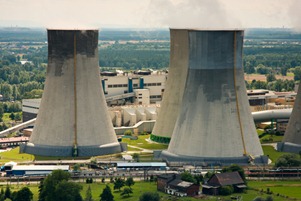Shutting Down of U.S. Nuclear Power Plants Looks Unlikely Despite Dangers
 Last week, a group of 25 environmental organizations, including the Green Party of Ohio, Riverkeeper and the Michigan Chapter of the Sierra Club, filed challenges to all the permits the Nuclear Regulatory Commission (NRC) currently has under review. The challenges demand that the NRC’s task force report on Fukushima be taken into account before the agency act on the licenses in question.
Last week, a group of 25 environmental organizations, including the Green Party of Ohio, Riverkeeper and the Michigan Chapter of the Sierra Club, filed challenges to all the permits the Nuclear Regulatory Commission (NRC) currently has under review. The challenges demand that the NRC’s task force report on Fukushima be taken into account before the agency act on the licenses in question.
Since Japan’s nuclear disaster at Fukushima demonstrated that an unlikely natural event can ace human expectations any time, there have been calls to shut down all nuclear plants in the United States within the next few years. There is no question that this would be very desirable. Many of the 184 reactors that are currently operating in the United States are located perilously near major centers of population. Many of them are old – possibly beyond their expected life cycle — and some appear to be badly maintained, judging by their list of violations. Even plants that have updated and well-maintained reactors have large pools of spent fuel rods that lie open to the air and only protected against likely eventualities, not against the desperation and ingenuity that terrorists may bring to their destruction.
Nevertheless, those calls for a nuclear shut-down are not likely to bear fruit. They are much more likely to be thwarted by the behemoth of an industry that already has several new billion-dollar plants well on the way to funding and construction.
But this situation is not merely due to the machinations of powerful interests within the industry. The problem is the same as America’s need for oil. Although that need imperils our physical and economic well-being and our security, that need is not just fed by the workings of powerful oil companies but by a national inability to move to alternate power sources. In the same way, our dependence on nuclear power has been built up over the decades since Eisenhower promulgated the policy of “Atoms for Peace.” We get a full 20 per cent of our electricity from our 106 nuclear power plants, many of which are located near the population centers they serve. New York’s Indian Point, with three reactors – one of which is permanently shut down — supplies 20 per cent of the electricity used by New York City, only 38 miles downstream of the facility. Although New York State governors from Pataki to Cuomo have called for Indian Point’s shut-down, its central role as electricity provider lets it persist as the gorilla in the State’s gubernatorial office.
This situation exists despite the fact that no new facilities have been licensed since 1977, when the nuclear accident at Three-Mile Island in Pennsylvania blew away our complacency about the safety of nuclear power. At that time, new nuclear facilities were put on indefinite hold, and no entirely new ones have been built to date.
Nevertheless, our nuclear capacity has increased over that time. Forty-seven reactors that were already at various stages of development and construction in 1977 were completed and came on line in the succeeding 20 years. Despite the moratorium, existing reactors have been permitted to “uprate” – to increase the amount of electricity they can generate – by some 6000 MKwH. They have accomplished this by using more or larger fuel rods in the reactor, and upgrading the plant to handle the additional capacity. In some cases, this has merely involved some new piping. In others, almost the whole plant was refitted, including newer and larger turbines.
Although there has been controversy about some plants having serious violations and some being passed with questionable maintenance practices, little has been made public about the aging of equipment that may have been brought on line as long as 40 years ago. The initial licenses ran 40 years, but the span was based on the companies’ need for time to amortize and profit from their investments rather than on the possible operation of the equipment past its useable life span.
Back then, calculations for the lifespan of complex systems like reactors and power plants were not readily available. It has only been with the development of computers and complex programs that we have been able to address such relatively mundane, but important industrial problems. The NRC has not required that the systems in older nuclear plants be subjected to such an evaluation, even though it has extended the licenses for 66 reactors an additional 20 years to date.
Over the last five years, with Three Mile Island fading from public memory, work has proceeded quietly on several new reactors. The first one to come on line will be the TVA’s Watts Bar 2, the companion to Watts Bar 1, which was the last of the old reactors to come on line, in 1996. It is most likely that the new units will not only be more efficient and more productive than their predecessors, they will also be safer. But for all the older units, we have to ask: how safe are 40-year-old nuclear power plants that may have never been fully evaluated by techniques now available? We can only hope that we will not hear about them at all.


